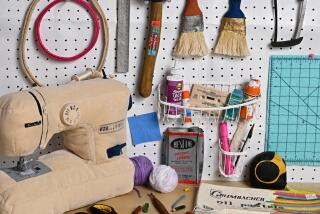City Program Seeks to Preserve, Present Folk Art and Crafts
In hidden corners of this glittery city known for its movies and way-out fads, Armenian women spend hours making lace by hand. Afro-Americans are quilting. Indians are holding powwows.
Folk art is alive and flourishing, partly because of a new city program dedicated to preserving myriad dying arts practiced by Los Angeles’ many-faceted ethnic population.
Heading up the Folk Arts Program through the city’s Cultural Affairs Department is Susan Auerbach, a 30-year-old ethnomusicologist from Seattle. Her mission is far-flung but her energy appears boundless.
“Especially in a large city where lots of different populations are trying to carve out lives for themselves, people need to hold onto some banner of identity,” she said.
“These kinds of art forms provide a connection to the past. They provide a kind of window on our neighbors in a city as diverse as this. We are trying to enhance understanding and give a boost to community life.”
With $50,000 from the California Arts Council, the 6-month-old Folk Arts Program is trying to preserve, promote and present traditional arts.
Usually, Auerbach spends a good chunk of her time stalking the streets of Los Angeles in search of folk art traditions crying out for preservation. But lately she is desk-bound, sifting through more than 40 applications for a share of grant money.
The applicants run the gamut of ideas: a Cambodian refugee offers a training program in classical Cambodian dance; a Salvadoran wood carver wants to hold woodcarving workshops, another applicant wants to make a documentary about a mural-filled folk art environment in a black neighborhood of Los Angeles.
The diversity is mind-boggling. The paper work reflects an abundance of dance, craft, music, food and storytelling talent from all over the world. Financial support is very important to ethnic groups, Auerbach said, because it helps them retain a sense of identity by helping them perpetuate their traditions.
“The pressure to assimilate is tremendous,” she said. “It’s especially important in L.A., which is the new Ellis Island, that a city like this has a commitment on a governmental level to recognize, honor and nurture the cultures that its populations are coming from.”
Showcase Folk Art
The Folk Arts Program not only encourages the definition and continuation of traditional arts, but wants to showcase them with festivals, concerts, exhibits and documentaries. The program either sponsors such an event directly or gives money to a group that wants to put it on.
Traditional art, Auerbach emphasized, does not need to be old to qualify for city money. One modern, local trend that could qualify as folk art is what Auerbach termed “freeway lore,” the bumper-sticker and personalized license plate life style that has sprung up on Los Angeles freeways.
The program’s first major public events will be coming up this spring. Among the things scheduled are a Thai festival at Barnsdall Art Park on April 26. Highlighting the festival will be vegetable carving workshops, an art form developed in the royal courts of Thailand hundreds of years ago, she said.
Also planned is a workshop and discussion with an inter-generation team of Afro-American patchwork quilters who range in age from 36 to 80.
More to Read
The biggest entertainment stories
Get our big stories about Hollywood, film, television, music, arts, culture and more right in your inbox as soon as they publish.
You may occasionally receive promotional content from the Los Angeles Times.










